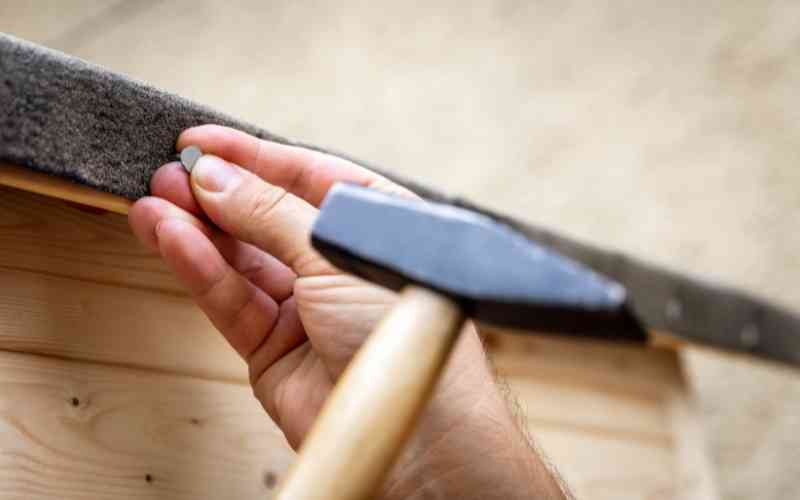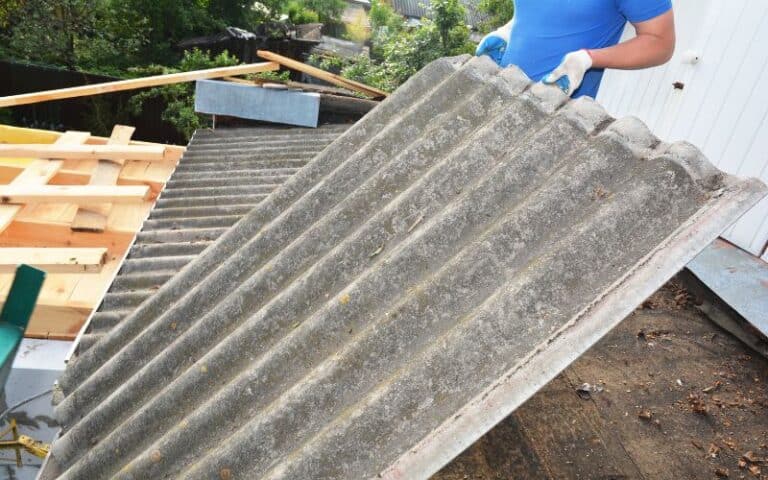Roofing felt nails or staples are effective roofing methods or options that can go well with very soft materials.
They are widely used and have been recognized as effective methods of holding roofing felt or underlayments and can be used for several small-scale buildings or larger building projects.
Nails and staples have several significant differences. Choosing the suitable fastener for your roof or shingle is dependent on four factors; the type of fastener, correct installation, placement, and holding strength.
Ready for a Roofing Quiz?
What’s The Difference Between Staple And Nails?

Roofing felt nails or staples in time past was quite challenging to distinguish which of the two roofing options is better clearly.
However, most roofers prefer staples because they are less expensive, have outstanding holding power, and enable roofers to work faster by covering an extensive space with their compact collection.
As a bonus, roofing staplers are easy to handle and do not require many repairs. Many factors have influenced the shift from using felt nails in modern times.
First, its available capacity load, adjustable drive depth, and universal design make compatibility easy: the nails and the shingle.
However, in recent years, like in the last two decades, staples have been banned as an option for roofing and shingles because of fear of an incorrect installation.
Nevertheless, the proper thing to do is always to check the requirements of your local building authority before starting or embarking on a building project.
You can also install asphalt shingle roofs using either a staple or nailer. For asphalt shingle nails, a galvanized roofing nail with at least 12 gauge shank and head diameter 3/8 inch, while the stapler requires a 16 gauge staple gun.
These factors above determine if your nail or staple underlayment is good enough to hold your roof. In addition, roof staples are affordable, easy to work with, and can be used for diverse building projects.
Unfortunately, when it comes to asphalt shingle roofs, they fall short in having enough holding strength. As a result, most local building authorities have banned staples for roofing.
Staple guns are much easier to handle or work with; this is an added advantage of staples.
But at the same time, you have a lot of jams on the felt paper while working with nail guns, roofers who use staples any form of jam.
Aside from the lightweight of the roof staples, it is highly inexpensive and cost-effective, which is one of the reasons why most individuals or companies prefer to use them.
Recently, things have changed as staples are no longer fancied or used as roofing felt underlayment.
They require high skills and concentration when used, and any mistake or inaccurate placement can cause severe damage to the entire roof.
Staples also have lower holding strength when compared to nails. They also go against most building code error codes and local building authority standards.
In addition, the chances are that You can install staples incorrectly or inaccurately. They can also be overdriven or even underdriven.
On the other hand, Roof nails have a more substantial and extended holding strength. As a result, roof nails can last for over 50 years, and most last for more extended periods provided the building is still standing.
This goes a long way to bring to light how durable nail roofs are. This inarguably depends significantly on the type of nails used.
In areas where you can use extreme weather conditions, such as wind-driven rain, ring shank copper nails to seal or resist strong winds blowing over the roofs.
Nail guns are pretty easy to use as there is no risk of an incorrect installation even if the gun is not held in the correct position. In addition, nails are stable and allow roofers to get precise points when using them.
The use of nails for roofing in an area may differ from another, but they are primarily similar; therefore, it is difficult to go against building codes when using roofing nails.
Most building codes regulate that at least a 12 gauge shank with a diameter of 3/8 head be used. Fortunately, galvanized roofing nails and steel nails pass the building code test.
Also, you can use an aluminum or copper nail, depending on your location. The downside of roof nails is that they are bulkier and prone to multiple jams while working with them.
Its working rate is prolonged but heavyweight, making work tiring. The differences between the stable and nails are visible.
The roofing nails outweigh the roofing staples’ durability, holding power, installation, extended use, and compliance with local building authority codes.
Do You Nail Or Staple Roofing Felt?
It’s general knowledge that nail roofing felt, and staples are almost the same and give desired results: securing or holding the roofing felt.
Nevertheless, it is essential always to consult the products to see if the producers have a laid-down procedure of which of the two roofing options are best for their products and how you should use them.
There are certain qualities that roofing felt underlayment must possess. Qualities such as good waterproof ability even in every kind of weather, especially in areas with very high wind and a tendency for wind-influenced rain.
Another quality is its ability to withstand intense exposure to the sun over a long period. It is important to note that the nail and staple roofing felt have these outstanding qualities.
Therefore, settling to use any of your options depends mainly on the slope of the roof of the building they are being installed on.
In addition to these, nail felts are made from steel and used only to secure the roofing felt underlayment.
That is why they are used for additional water tightness in extensive wind areas to reduce the chances of wearing and tearing.
Most of the time, staples do not hold down the roofing felt paper or materials well enough in such areas. Staples also provide great finishing outlooks on your roofing or other building projects.
Even though nails also hold roofing materials in place, staples are often preferred because they have a solid visible grip.
The most pronounced advantage of the staple over the nail is that roofing staple guns can install four staples at once while nail guns can not.
This means that using a staple to nails is four staples to 1 nail.
Can You Use Staples For Roofing?
Depending on your local building authority, you can use staples for roofing felt or, in other words, as roofing felt underlayment.
This provides short-term protection and serves as a waterproof so that water or moisture does not move below the tiles or shingles.
Roofing felt underlayment before installation often corresponds with the local building codes and makes it easier to keep insects, vectors, and even dust particles away from the building.
Directly answering if you can use staples for roofing felt depends on your local building authority and fire codes.
They may or not allow staple roofing felt. Staples are faster and easier to use as an underlayment.
Besides, the type of underlayment used for roofing material is not much to bother because they are held mainly by many layers of shingles that weigh higher above the roofing felt underlayment itself.
What Size For Roofing Felt?
The standard size for roofing felt paper is categorized into four. We have the following;
- 3/8″ x “3/8
- 7/16″ x 1 – 1/2″
- 1/2″ x 5/16″
- 1 x 5/8
For galvanized roofing shingles, they make use of a 16 gauge shank. You can learn more about the sizes of staples here.
Conclusion
Nails and staples are standard roofing underlayment options that you can use on all building products. They are easy to install and are unique in their work and functions.
Factors such as type of fastener, accurate installation, placement, holding strength, and local building authority codes all influence why people choose nail or staple fastener for their roofing felt underlayment.






